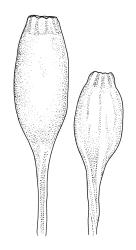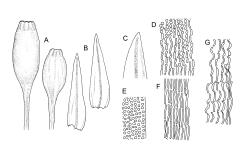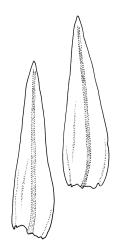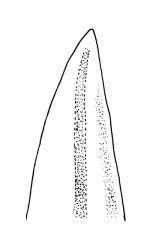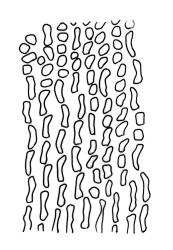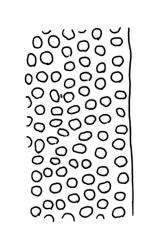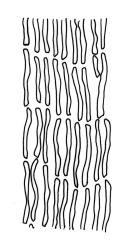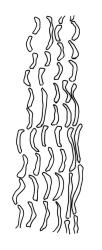- ≡ Orthotrichum longipes Hook., Musci Exot. 1, 24 (1818)
- = Macromitrium lonchomitrium Müll.Hal., Hedwigia 37: 148 (1898)
- = Macromitrium pseudohemitrichodes Müll.Hal., Hedwigia 37: 150 (1898)
Plants robust, lustrous, gold-green to bronze-brown above, chestnut-brown below, mostly on bark. Branches variable in length, mostly <25 (often <10) mm, ascendant, simple or forking below sex organs. Stem leaves twisted-flexuose when dry, ovate-lanceolate, gradually tapered to broadly subulate apices, 1.5–2.0 mm. Branch leaves in spiral ranks and with recurved-twisted or decurved apices when dry, slightly curved, funiculate, and spiralled when moist, broadly-lanceolate to ligulate-lanceolate, ± acute, strongly keeled throughout, with a single, usually strong plication below; 1.5–3.0 mm; margins entire, recurved on one or both sides below; upper laminal cells isodiametric and rounded to subquadrate, usually very thick-walled, flat or slightly bulging, smooth, unistratose, mostly 7–9 μm diam. (lumina 3–8 μm diam.); mid laminal cells rectangular, unevenly thick-walled, with elongate and strongly curved to sigmoid lumina, smooth, clear; 15–30(–40) × 8–12 μm (lumina c. 2–3 μm wide); inner basal cells elongate-rectangular, more evenly thick-walled, with the lumina straight to sinuose; 16–55(–60) × 8–12 μm (lumina 2–4 μm wide); marginal basal cells longer and narrower, not forming a distinct border. Costa ending few cells below apex, curving to one side above, the abaxial superficial cells elongate throughout, in cross-section with one layer of 3–5 guide cells and 2–3 rows of abaxial stereids. Gemmae absent.
Dioicous. Perichaetial leaves larger than vegetative but otherwise little differentiated, oblong-lanceolate, acute to acuminate-apiculate, erect, straight, and weakly sheathing the lower setae when moist, 3–4 mm. Male plants well-developed (not dwarfed); perigonia usually inconspicuous, terminal and sometimes multiple at swollen tips of branches, the inner bracts ovate-acute and c. 1 mm, antheridia and paraphyses numerous. Setae very long, (7–)10–25 mm, smooth, straight or flexuose, slender, sinistrorse; capsules broadly elliptic-ovate to fusiform-cylindric, smooth below, becoming 8-plicate beneath mouth, dark brown and ± shiny, 1.3–2.5 mm; exothecial cells thick-walled, irregularly rounded to long-rectangular; mostly 14–40(–55) μm long; stomata and annulus as per genus; operculum c. 1–1.5 mm. Peristome single; exostome teeth 16, well-developed, inflexed when dry, lanceolate, pale, c. 120–200 μm, coarsely papillose on transverse striae of the inner surface, finely and ± evenly papillose on outer surface. Calyptra very large and tightly clasping the developing capsule, to 5 mm, deeply and evenly lacerate, strongly plicate and naked. Spores isosporous, 26–66 μm diam. (varying up to 15 μm diam. in single capsule), sparsely papillose, mostly thick-walled.
Sainsbury 1955, pl. 37, fig. 2; Vitt 1983, figs 70–82, 85; Beever et al. 1992, fig. 36 a–f; Malcolm & Malcolm 2003, p. 43.
Macromitrium longipes is the largest and arguably the most common species of its genus in N.Z. It is readily distinguished from all other species except M. microstomum and M. orthophyllum by the smooth (non-papillose) and flat upper laminal cells and the strongly funiculate set of the branch leaves. The predominance of chestnut-brown and red tones, and large size of the plants is often sufficient for recognition of the species in the field. However, small plants and those without the distinctive coloration can be confused with M. microstomum. Such smaller-than-usual plants are best differentiated by the sigmoid, highly curved mid laminal cell lumina of M. longipes as compared to the nearly straight lumina of M. microstomum. Also, M. longipes is dioicous and its perichaetial leaves are broadly acute and rather stout, whereas M. microstomum is autoicous and its perichaetial leaves are slenderly acuminate and delicate. Features distinguishing M. longipes from the related M. orthophyllum are mentioned under the latter species.
The spores of M. longipes are isosporous, but in a single capsule usually vary c. 15 μm in diam. from smallest to largest. Between-population spore variability is also great, some being very thick-walled and others thin-walled, but uniform within a single capsule. Setae vary in length from 7 to 25 mm but most other structural features are generally not variable, making M. longipes one of the most distinctive species of its genus in N.Z.
K; NI: N Auckland, including offshore islands (LB, GB), S Auckland, Gisborne, Hawke's Bay, Taranaki, Wellington; SI: Nelson, Marlborough, Canterbury, Westland, Otago, Southland; St; Ch; Sol.
Endemic.
Although known from all South I. L.D., in Canterbury it is known only from near the Main Divide, extending eastwards to about Cass, and this reflects its general rarity in drier parts of the South I. However, it does occur in forest remnants in the drier eastern parts of the North I.
It is most often collected from southern beech (especially Lophozonia menziesii, but also from Fuscospora fusca, F. solandri s.l., and F. truncata) and in wetter regions it is often abundant on both trunks and canopy branches. Additionally, it occurs on a very wide range of native angiosperms (including Archeria traversii, Beilschmiedia tarairi, Coprosma parviflora, Coriaria sp., Dracophyllum arboreum, D. filifolium, D. longifolium, Knightia excelsa, Leptospermum scoparium, Leucopogon fasciculatus, Myrsine chathamica, Olearia colensoi, O. ilicifolia, Pittosporum umbellatum, Pseudowintera colorata, Weinmannia racemosa, and W. silvicola) and gymnosperms (including Agathis australis, Dacrycarpus dacrydioides, Dacrydium cupressinum, Phyllocladus alpinus, and Podocarpus totara) as well as some introduced woody species (e.g., Alnus glutinosa and Ulex europaeus). It occasionally also grows on rock (including volcanics, greywacke, and limestone). It is sometimes recorded from rotten logs but such occurrence probably reflects persistence on fallen branches rather than actual colonisation. It rarely grows where it is subject to salt spray. In some subalpine areas it forms the dominant component of the epiphytic flora, especially in Lophozonia menziesii-dominated forests. Ranging from c. 100 m (Waipoua Forest, N Auckland L.D.) to c. 1450 m (Mt Ruapehu, Wellington L.D.) elevation on the North I. and from sea level (Papatōwai, Otago L.D. & Resolution I., Southland L.D.) to at least 1150 m (Mt Euclid, Nelson L.D.) on the South I.
Its wide range of host species is reflected in a range of bryophyte associates including Cladomnion ericoides, Dicnemon calycinum, D. semicryptum, Holomitrium perichaetiale, Macromitrium prorepens, Mesotus celatus, Ulota lutea, Chandonanthus squarrosus, and Jamesoniella monodon.
Macromitrium longipes is placed by Vitt & Ramsay (1985) in their "M. microstomum group" with the widespread M. microstomum and the N.Z. endemic M. orthophyllum. Four Australian endemic species are also placed here.



